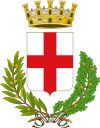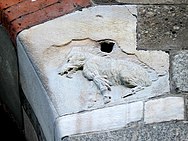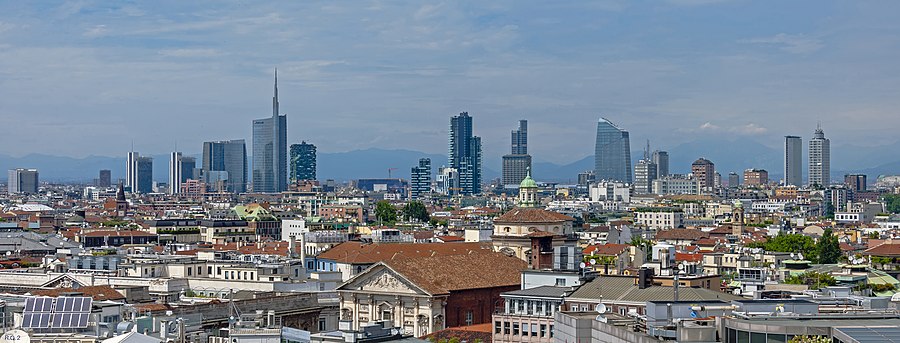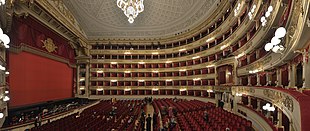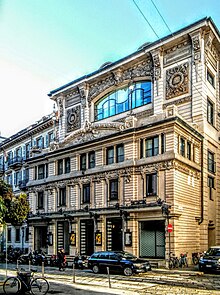Milan
Jump to navigationJump to search
|
Milan
Milano (Italian)
|
|
|---|---|
| Comune di Milano | |
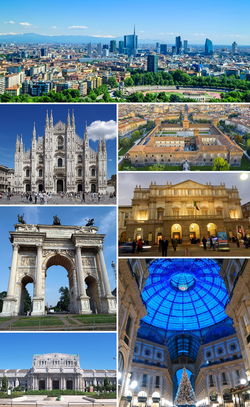
Clockwise from top: Porta Nuova, Sforza Castle, La Scala, Galleria Vittorio Emanuele II, Milano Centrale railway station, Arch of Peace and Milan Cathedral.
|
|
|
|
|
| Coordinates: 45°28′01″N 09°11′24″ECoordinates: 45°28′01″N 09°11′24″E | |
| Country | |
| Region | Lombardy |
| Metro | Milan (MI) |
| Government | |
| • Type | Strong Mayor–Council |
| • Body | Milan City Council |
| • Mayor | Giuseppe Sala (PD) |
| Area | |
| • Comune | 181.76 km2 (70.18 sq mi) |
| Elevation | 120 m (390 ft) |
| Population
(January 31, 2020)[1]
|
|
| • Comune | 1,397,852 |
| • Density | 7,700/km2 (20,000/sq mi) |
| • Metro | 4,336,121 |
| Demonym(s) | Milanese Meneghino[3] |
| Area code(s) | 0039 02 |
| Website | www.comune.milano.it |
Milan (/mɪˈlæn/, US also /mɪˈlɑːn/,[4][5] Milanese: [miˈlãː] (![]() listen); Italian: Milano [miˈlaːno] (
listen); Italian: Milano [miˈlaːno] (![]() listen))[6][7] is a city in northern Italy, capital of Lombardy, and the second-most populous city in Italy after Rome. Milan served as the capital of the Western Roman Empire, the Duchy of Milan and the Kingdom of Lombardy–Venetia. The city proper has a population of about 1.4 million[8] while its metropolitan city has 3.26 million inhabitants.[9] Its continuously built-up urban area, that stretches well beyond the boundaries of the administrative metropolitan city, is the fourth largest in the EU with 5.27 million inhabitants.[10] The population within the wider Milan metropolitan area, also known as Greater Milan, is estimated at 8.2 million, making it by far the largest metropolitan area in Italy and the 3rd largest in the EU.[11][12]
listen))[6][7] is a city in northern Italy, capital of Lombardy, and the second-most populous city in Italy after Rome. Milan served as the capital of the Western Roman Empire, the Duchy of Milan and the Kingdom of Lombardy–Venetia. The city proper has a population of about 1.4 million[8] while its metropolitan city has 3.26 million inhabitants.[9] Its continuously built-up urban area, that stretches well beyond the boundaries of the administrative metropolitan city, is the fourth largest in the EU with 5.27 million inhabitants.[10] The population within the wider Milan metropolitan area, also known as Greater Milan, is estimated at 8.2 million, making it by far the largest metropolitan area in Italy and the 3rd largest in the EU.[11][12]
Milan is considered a leading alpha global city,[13] with strengths in the fields of art, commerce, design, education, entertainment, fashion, finance, healthcare, media, services, research and tourism. Its business district hosts Italy’s stock exchange (Italian: Borsa Italiana), and the headquarters of national and international banks and companies. In terms of GDP, it has the second-largest economy among EU cities after Paris, and is the wealthiest among EU non-capital cities.[14][15] Milan is considered part of the Blue Banana and one of the “Four Motors for Europe“.
The city has been recognized as one of the world’s four fashion capitals[16] thanks to several international events and fairs, including Milan Fashion Week and the Milan Furniture Fair, which are currently among the world’s biggest in terms of revenue, visitors and growth.[17][18][19] It hosted the Universal Exposition in 1906 and 2015. The city hosts numerous cultural institutions, academies and universities, with 11% of the national total of enrolled students.[20] Milan is the destination of 8 million overseas[citation needed] visitors every year, attracted by its museums and art galleries that include some of the most important collections in the world, including major works by Leonardo da Vinci. The city is served by many luxury hotels and is the fifth-most starred in the world by Michelin Guide.[21] The city is home to two of Europe’s most successful football teams, A.C. Milan and F.C. Internazionale, and one of Europe’s main basketball teams, Olimpia Milano. Milan will host the 2026 Winter Olympics together with Cortina d’Ampezzo.
Toponymy[edit]
The etymology of the name Milan (Lombard: Milan [miˈlãː]) remains uncertain. One theory holds that the Latin name Mediolanum comes from the Latin words medio (in the middle) and planus (plain).[22] However, some scholars believe that lanum comes from the Celtic root lan, meaning an enclosure or demarcated territory (source of the Welsh word llan, meaning “a sanctuary or church”, ultimately cognate to English/German Land) in which Celtic communities used to build shrines.[23] Hence Mediolanum could signify the central town or sanctuary of a Celtic tribe. Indeed, about sixty Gallo-Roman sites in France bore the name “Mediolanum”, for example: Saintes (Mediolanum Santonum) and Évreux (Mediolanum Aulercorum).[24] In addition, another theory links the name to the boar sow (the Scrofa semilanuta) an ancient emblem of the city, fancifully accounted for in Andrea Alciato‘s Emblemata (1584), beneath a woodcut of the first raising of the city walls, where a boar is seen lifted from the excavation, and the etymology of Mediolanum given as “half-wool”,[25] explained in Latin and in French. According to this theory, the foundation of Milan is credited to two Celtic peoples, the Bituriges and the Aedui, having as their emblems a ram and a boar;[26] therefore “The city’s symbol is a wool-bearing boar, an animal of double form, here with sharp bristles, there with sleek wool.”[27] Alciato credits Ambrose for his account.[28]
History[edit]
Prehistory and Roman times[edit]

Roman ruins in Milan: the Columns of San Lorenzo.

The remains of the Milan amphitheatre, which can be found inside the archaeological park of the Antiquarium in Milan.
The Celtic Insubres, the inhabitants of the region of northern Italy called Insubria, appear to have founded Milan around 600 BC. According to the legend reported by Livy (writing between 27 and 9 BC), the Gaulish king Ambicatus sent his nephew Bellovesus into northern Italy at the head of a party drawn from various Gaulish tribes; this Bellovesus allegedly founded Mediolanum in the time of the Roman monarchy, during the reign of Tarquinius Priscus. Tarquin is traditionally recorded as reigning from 616 to 579 BC, according to ancient Roman historian Titus Livy.[29] During the Roman Republic, the Romans led by consul Gnaeus Cornelius Scipio Calvus, fought the Insubres and captured the city in 222 BC. The chief of the Insubres then submitted to Rome, giving the Romans control of the city.[30] They eventually conquered the entirety of the region, calling the new province “Cisalpine Gaul” (Latin: Gallia Cisalpina) – “Gaul this side of the Alps” – and may have given the site its Latinized Celtic name of Mediolanum: in Gaulish *medio- meant “middle, center” and the name element -lanon is the Celtic equivalent of Latin -planum “plain”, thus *Mediolanon (Latinized as Mediolānum) meant “(settlement) in the midst of the plain”.[31][32]
In 286 the Roman Emperor Diocletian moved the capital of the Western Roman Empire from Rome to Mediolanum.[33]
Diocletian himself chose to reside at Nicomedia in the Eastern Empire, leaving his colleague Maximian at Milan. Maximian built several gigantic monuments, the large circus (470 × 85 metres), the thermae or “Baths of Hercules”, a large complex of imperial palaces and other services and buildings of which fewer visible traces remain. Maximian increased the city area surrounded by a new, larger stone wall (about 4.5 km long) encompassing an area of 375 acres with many 24-sided towers. The monumental area had twin towers; one included in the convent of San Maurizio Maggiore remains 16.6 m high.
From Mediolanum the Emperor Constantine issued the Edict of Milan in 313 AD, granting tolerance to all religions within the Empire, and thus paving the way for Christianity to become the dominant religion of Roman Europe. Constantine had come to Mediolanum to celebrate the wedding of his sister to the Eastern Emperor, Licinius. In 402 the Visigoths besieged the city and the Emperor Honorius moved the Imperial residence to Ravenna.[34] In 452 Attila in his turn besieged Mediolanum, but the real break with the city’s Imperial past came in 539, during the Gothic War, when Uraia (a nephew of Witiges, formerly King of the Italian Ostrogoths), laid Mediolanum to waste with great loss of life.[35] The Lombards took Ticinum as their capital in 572 (renaming it Papia – the modern Pavia), and left early-medieval Milan to the governance of its archbishops.
Middle Ages[edit]

The Medieval Porta Ticinese (1100), is one of the three medieval gates of the city that still exist in the modern Milan.

The late 16th-century city encircled by the Spanish walls.

Milan during the plague of 1630: plague carts carry the dead for burial.
After the city was besieged by the Visigoths in 402, the imperial residence was moved to Ravenna. An age of decline began which worsened when Attila, King of the Huns, sacked and devastated the city in 452 AD. In 539, the Ostrogoths conquered and destroyed Milan during the Gothic War against Byzantine Emperor Justinian I. In the summer of 569 the Lombards (from which the name of the Italian region Lombardy derives), conquered Milan, overpowering the small Byzantine garrison left for its defence. Some Roman structures remained in use in Milan under Lombard rule.[36] Milan surrendered to Charlemagne and the Franks in 774.
The 11th century saw a reaction against the control of the German emperors. The city-state was born, an expression of the new political power of the city and its will to fight against all feudal powers. Milan was no exception. It did not take long, however, for the City States to begin fighting each other to try to limit neighbouring powers.[37] The Milanese destroyed Lodi and continuously warred with Pavia, Cremona and Como, who in turn asked the Emperor of Germany, Frederick I Barbarossa for help. This brought the destruction of much of Milan in 1162. A fire destroyed the storehouses containing the entire food supply, and within just a few days Milan was forced to surrender.
A period of peace followed and Milan prospered as a centre of trade due to its position. As a result of the independence that the Lombard cities gained in the Peace of Constance in 1183, Milan became a duchy. In 1447 Filippo Maria Visconti, Duke of Milan, died without a male heir; following the end of the Visconti line, the Ambrosian Republic was established; it took its name from St. Ambrose, the popular patron saint of the city.[38] Both the Guelph and the Ghibelline factions worked together to bring about the Ambrosian Republic in Milan. Nonetheless, the Republic collapsed when, in 1450, Milan was conquered by Francesco I of the House of Sforza, which made Milan one of the leading cities of the Italian Renaissance.[38][39]
Early modern[edit]
Milan’s last independent ruler, Lodovico il Moro, requested the aid of Charles VIII of France against the other Italian statelets, eventually unleashing the Italian Wars. The king’s cousin, Louis of Orléans, took part in the expedition and realized Italy was virtually defenseless. This prompted him to come back a few years later in 1500, and claim the Duchy of Milan for himself, his grandmother having been a member of the ruling Visconti family. At that time, Milan was also defended by Swiss mercenaries. After the victory of Louis’s successor François I over the Swiss at the Battle of Marignan, the duchy was promised to the French king François I. When the Spanish Habsburg Emperor Charles V defeated François I at the Battle of Pavia in 1525, northern Italy, including Milan, passed to Habsburg Spain.[40]

Ceremonial reception of Russian Field Marshal Alexander Suvorov in Milan, April 1799
In 1556, Charles V abdicated in favour of his son Philip II and his brother Ferdinand I. Charles’s Italian possessions, including Milan, passed to Philip II and remained with the Spanish line of Habsburgs, while Ferdinand’s Austrian line of Habsburgs ruled the Holy Roman Empire. The Great Plague of Milan in 1629–31, that claimed the lives of an estimated 60,000 people out of a population of 130,000, caused unprecedented devastation in the city and was effectively described by Alessandro Manzoni in his masterpiece “The Betrothed“. This episode was seen by many as the symbol of Spanish bad rule and decadence and is considered one of the last outbreaks of the centuries-long pandemic of plague that began with the Black Death.[41]
In 1700 the Spanish line of Habsburgs was extinguished with the death of Charles II. After his death, the War of the Spanish Succession began in 1701 with the occupation of all Spanish possessions by French troops backing the claim of the French Philippe of Anjou to the Spanish throne. In 1706, the French were defeated in Ramillies and Turin and were forced to yield northern Italy to the Austrian Habsburgs. In 1713–1714 the Treaties of Utrecht and Rastatt formally confirmed Austrian sovereignty over most of Habsburg Spain’s Italian possessions including Lombardy and its capital, Milan. Napoleon invaded Italy in 1796, and Milan was declared capital of the Cisalpine Republic. Later, he declared Milan capital of the Kingdom of Italy and was crowned in the Duomo. Once Napoleon’s occupation ended, the Congress of Vienna returned Lombardy, and Milan, to Austrian control in 1815.
Late modern and contemporary[edit]
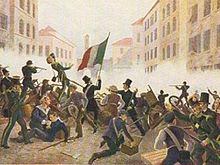
Popular print depicting the “Five Days” uprising against Austrian rule.
On March 18, 1848 Milan efficaciously rebelled against Austrian rule, during the so-called “Five Days” (Italian: Le Cinque Giornate), that forced Field Marshal Radetzky to temporarily withdraw from the city. The bordering kingdom of Piedmont-Sardinia sent troops in order to protect the insurgents and organsied a plebiscite that ratified by a huge majority the unification of Lombardy with Piedmont-Sardinia. But just a few months later the Austrians were able to send fresh forces that routed the Piedmontese army at the Battle of Custoza on 24 July and to reassert Austrian control over northern Italy. About ten years later, however, Italian nationalist politicians, officers and intellectuals such as Cavour, Garibaldi and Mazzini were able to gather a huge consensus and to pressure the monarchy to forge an alliance with the new French Empire of Napoleon III in order to defeat Austria and establish a large Italian state in the region. At the Battle of Solferino in 1859 French and Italian troops heavily defeated the Austrians that retreated under the Quadrilateral line.[42] Following this battle, Milan and the rest of Lombardy were incorporated into Piedmont-Sardinia, which then proceeded to annex all the other Italian statlets and proclaim the birth of the Kingdom of Italy on March 17, 1861.
The political unification of Italy enhanced Milan’s economic dominance over northern Italy. A dense rail network, whose construction had started under Austrian patronage, was completed in a brief time, making Milan the rail hub of northern Italy and, with the opening of the Gotthard (1882) and Simplon (1906) railway tunnels, the major South European rail hub for goods and passenger transport. Indeed, Milan and Venice were among the main stops of the Orient Express that started operating from 1919. Abundant hydroelectric resources allowed the development of a strong steel and textile sector and, as Milanese banks dominated Italy’s financial sphere, the city became the country’s leading financial centre. Very rapid industrialization in the last two decades of the 1800s led to the birth of a massive worker class as well as bitter social conflicts. In May 1898 Milan was shaken by the Bava Beccaris massacre, a riot related to soaring cost of living.
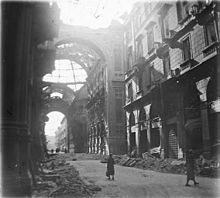
Galleria Vittorio Emanuele II destroyed by Allied bombings, 1943.

Pirelli Tower (foreground) and Galfa Tower (behind), here in a 1961 picture, became the symbol of the modernity and audacity of the Italian economic miracle.
Milan’s economic dominance in Italy secured also a leading role for the city on the political scene. It was in Milan that Benito Mussolini built his political and journalistic careers, and his fascist Blackshirts rallied for the first time in the city’s Piazza San Sepolcro; here the future Fascist dictator launched his March on Rome on 28 October 1922. During the Second World War Milan large industrial and transport facilities suffered extensive damage from Allied bombings that often hit also residential districts.[43] When Italy surrendered in 1943, German forces occupied and plundered most of northern Italy, fueling the birth of a massive resistance guerrilla movement.[44] On April 29, 1945 the American 1st Armored Division was advancing on Milan but, before it arrived, the Italian resistance seized control of the city and executed Mussolini along with his mistress and several regime officers, that were later hanged and exposed in Piazzale Loreto, where one year before some resistance members had been executed.
During the post-war economic boom, the reconstruction effort and the so-called Italian economic miracle attracted a large wave of internal migration (especially from rural areas of southern Italy) to Milan. The population grew from 1.3 million in 1951 to 1.7 million in 1967.[45] During this period, Milan was rapidly rebuilt, with the construction of several innovative and modernist skyscrapers, such as the Torre Velasca and the Pirelli Tower, that soon became the symbols of this new era of prosperity.[46] The economic prosperity was, however, overshadowed in the late 1960s and early 1970s during the so-called Years of Lead, when Milan witnessed an unprecedented wave of street violence, labour strikes and political terrorism. The apex of this period of turmoil occurred on 12 December 1969, when a bomb exploded at the National Agrarian Bank in Piazza Fontana, killing seventeen people and injuring eighty-eight.

Piazza Castello during Expo 2015.
In the 1980s, with the international success of Milanese houses (like Armani, Versace and Dolce & Gabbana), Milan became one of the world’s fashion capitals. The city saw also a marked rise in international tourism, notably from America and Japan, while the stock exchange increased its market capitalisation more than five-fold.[47] This period led the mass media to nickname the metropolis “Milano da bere”, literally “Milan to drink”.[48] However, in the 1990s, Milan was badly affected by Tangentopoli, a political scandal in which many politicians and businessmen were tried for corruption. The city was also affected by a severe financial crisis and a steady decline in textiles, automobile and steel production.[46]
In the early 21st century, Milan underwent a series of sweeping redevelopments over huge former industrial areas.[49] Two new business districts, Porta Nuova and CityLife, were built in the space of a decade, radically changing the skyline of the city. Its exhibition centre moved to a much larger site in Rho.[50] The long decline in traditional manufacturing has been overshadowed by a great expansion of publishing, finance, banking, fashion design, information technology, logistics and tourism.[51] The city’s decades-long population decline seems to have partially reverted in recent years, as the comune gained about 100,000 new residents since the last census. The successful re-branding of the city as a global capital of innovation has been instrumental in its successful bids for hosting large international events such as 2015 Expo and 2026 Winter Olympics.
Geography[edit]
Topography[edit]
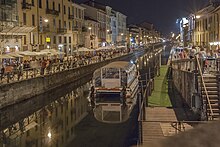
Navigli by night.
Milan is located in the north-western section of the Po Valley, approximately halfway between the river Po to the south and the foothills of the Alps with the great lakes (Lake Como, Lake Maggiore, Lake Lugano) to the north, the Ticino river to the west and the Adda to the east. The city’s land is flat, the highest point being at 122 m (400.26 ft) above sea level.
The administrative comune covers an area of about 181 square kilometres (70 sq mi), with a population, in 2013, of 1,324,169 and a population density of 7,315 inhabitants per square kilometre (18,950/sq mi). The Metropolitan City of Milan covers 1,575 square kilometres (608 sq mi) and in 2015 had a population estimated at 3,196,825, with a resulting density of 2,029 inhabitants per square kilometre (5,260/sq mi).[52] A larger urban area, comprising parts of the provinces of Milan, Monza e Brianza, Como, Lecco and Varese is 1,891 square kilometres (730 sq mi) wide and has a population of 5,270,000 with a density of 2,783 inhabitants per square kilometre (7,210/sq mi).[10]
The concentric layout of the city centre reflects the Navigli, an ancient system of navigable and interconnected canals, now mostly covered.[53] The suburbs of the city have expanded mainly to the north, swallowing up many comunes to reach Varese, Como, Lecco and Bergamo.[54]
Climate[edit]
Milan features a mid-latitude humid subtropical climate (Cfa), according to the Köppen climate classification. Milan’s climate is similar to much of Northern Italy’s inland plains, with hot, humid summers and cold, foggy winters. The Alps and Apennine Mountains form a natural barrier that protects the city from the major circulations coming from northern Europe and the sea.[55]
During winter, daily average temperatures can fall below freezing (0 °C [32 °F]) and accumulations of snow can occur: the historic average of Milan’s area is 25 centimetres (10 in) in the period between 1961 and 1990, with a record of 90 centimetres (35 in) in January 1985. In the suburbs the average can reach 36 centimetres (14 in).[56] The city receives on average seven days of snow per year.[57]
The city is often shrouded in heavy fog, although the removal of rice paddies from the southern neighbourhoods and the urban heat island effect have reduced this occurrence in recent decades. Occasionally, the Foehn winds cause the temperatures to rise unexpectedly: on 22 January 2012 the daily high reached 16 °C (61 °F) while on 22 February 2012 it reached 21 °C (70 °F).[58] Air pollution levels rise significantly in wintertime when cold air clings to the soil, causing Milan to be one of Europe’s most polluted cities.[59]
In summer, humidity levels are high and peak temperatures can reach temperatures above 35 °C (95 °F).[60] Usually this season enjoys clearer skies with an average of more than 13 hours of daylight:[61] when precipitations occur though, there is a higher likelihood of them being thunderstorms and hailstorms.[61] Springs and autumns are generally pleasant, with temperatures ranging between 10 and 20 °C (50 and 68 °F); these seasons are characterized by higher rainfall, especially in April and May.[62] Relative humidity typically ranges between 45% (comfortable) and 95% (very humid) throughout the year, rarely dropping below 27% (dry) and reaching as high as 100%[61] Wind is generally absent: over the course of the year typical wind speeds vary from 0 to 14 km/h (0 to 9 mph) (calm to gentle breeze), rarely exceeding 29 km/h (18 mph) (fresh breeze), except during summer thunderstorms when winds can blow strong. In the spring, gale-force windstorms may happen, generated either by Tramontane blowing from the Alps or by Bora-like winds from the north.[61]
| hideClimate data for Milan (Linate Airport), elevation: 107 m or 351 ft, 1971–2000 normals, extremes 1946–present | |||||||||||||
|---|---|---|---|---|---|---|---|---|---|---|---|---|---|
| Month | Jan | Feb | Mar | Apr | May | Jun | Jul | Aug | Sep | Oct | Nov | Dec | Year |
| Record high °C (°F) | 21.7 (71.1) |
23.8 (74.8) |
26.9 (80.4) |
32.4 (90.3) |
35.5 (95.9) |
36.6 (97.9) |
37.2 (99.0) |
36.9 (98.4) |
33.0 (91.4) |
28.2 (82.8) |
23.0 (73.4) |
21.2 (70.2) |
37.2 (99.0) |
| Average high °C (°F) | 5.9 (42.6) |
9.0 (48.2) |
14.3 (57.7) |
17.4 (63.3) |
22.3 (72.1) |
26.2 (79.2) |
29.2 (84.6) |
28.5 (83.3) |
24.4 (75.9) |
17.8 (64.0) |
10.7 (51.3) |
6.4 (43.5) |
17.7 (63.9) |
| Daily mean °C (°F) | 2.5 (36.5) |
4.7 (40.5) |
9.0 (48.2) |
12.2 (54.0) |
17.0 (62.6) |
20.8 (69.4) |
23.6 (74.5) |
23.0 (73.4) |
19.2 (66.6) |
13.4 (56.1) |
7.2 (45.0) |
3.3 (37.9) |
13.0 (55.4) |
| Average low °C (°F) | −0.9 (30.4) |
0.3 (32.5) |
3.8 (38.8) |
7.0 (44.6) |
11.6 (52.9) |
15.4 (59.7) |
18.0 (64.4) |
17.6 (63.7) |
14.0 (57.2) |
9.0 (48.2) |
3.7 (38.7) |
0.1 (32.2) |
8.3 (46.9) |
| Record low °C (°F) | −15.0 (5.0) |
−15.6 (3.9) |
−7.4 (18.7) |
−2.5 (27.5) |
−0.8 (30.6) |
5.6 (42.1) |
8.4 (47.1) |
8.0 (46.4) |
3.0 (37.4) |
−2.3 (27.9) |
−6.2 (20.8) |
−13.6 (7.5) |
−15.6 (3.9) |
| Average precipitation mm (inches) | 58.7 (2.31) |
49.2 (1.94) |
65.0 (2.56) |
75.5 (2.97) |
95.5 (3.76) |
66.7 (2.63) |
66.8 (2.63) |
88.8 (3.50) |
93.1 (3.67) |
122.4 (4.82) |
76.7 (3.02) |
61.7 (2.43) |
920.1 (36.22) |
| Average precipitation days (≥ 1.0 mm) | 6.7 | 5.3 | 6.7 | 8.1 | 8.9 | 7.7 | 5.4 | 7.1 | 6.1 | 8.3 | 6.4 | 6.3 | 83.0 |
| Average relative humidity (%) | 86 | 78 | 71 | 75 | 72 | 71 | 71 | 72 | 74 | 81 | 85 | 86 | 77 |
| Mean monthly sunshine hours | 58.9 | 96.1 | 151.9 | 177.0 | 210.8 | 243.0 | 285.2 | 251.1 | 186.0 | 130.2 | 66.0 | 58.9 | 1,915.1 |
| Source: Servizio Meteorologico[63][64][65] | |||||||||||||
| showClimate data for Milan (Malpensa Airport), elevation: 211 m or 692 ft, 1961-1990 normals |
|---|
Administration[edit]
Municipal government[edit]

Palazzo Marino, Milan City Hall
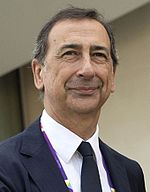
Giuseppe Sala, mayor since 2016
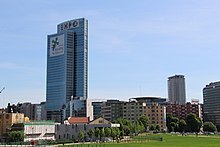
Palazzo Lombardia, headquarters of the regional government of Lombardy
The legislative body of the Italian comunes is the City Council (Consiglio Comunale), which in cities with more than one million population is composed by 48 councillors elected every five years with a proportional system, contextually to the mayoral elections. The executive body is the City Committee (Giunta Comunale), composed by 12 assessors, that is nominated and presided over by a directly elected Mayor. The current mayor of Milan is Giuseppe Sala, a left-wing independent leading a progressive alliance composed by Democratic Party, Italian Left and Italy of Values.
The municipality of Milan is subdivided into nine administrative Borough Councils (Consigli di Municipio), down from the former twenty districts before the 1999 administrative reform.[67] Each Borough Council is governed by a Council (Consiglio) and a President, elected contextually to the city Mayor. The urban organisation is governed by the Italian Constitution (art. 114), the Municipal Statute[68] and several laws, notably the Legislative Decree 267/2000 or Unified Text on Local Administration (Testo Unico degli Enti Locali).[69] After the 2016 administrative reform, the Borough Councils have the power to advise the Mayor with nonbinding opinions on a large spectrum of topics and are responsible for running most local services, such as schools, social services, waste collection, roads, parks, libraries and local commerce; in addition they are supplied with an autonomous funding in order to finance local activities.
Metropolitan city[edit]
Milan is the capital of the eponymous Metropolitan city. According to the last governmental dispositions concerning administrative reorganisation, the urban area of Milan is one of the 15 Metropolitan municipalities (città metropolitane), new administrative bodies fully operative since 1 January 2015.[70] The new Metro municipalities, giving large urban areas the administrative powers of a province, are conceived for improving the performance of local administrations and to slash local spending by better co-ordinating the municipalities in providing basic services (including transport, school and social programs) and environment protection.[71] In this policy framework, the Mayor of Milan is designated to exercise the functions of Metropolitan mayor (Sindaco metropolitano), presiding over a Metropolitan Council formed by 24 mayors of municipalities within the Metro municipality. The Metropolitan City of Milan is headed by the Metropolitan Mayor (Sindaco metropolitano) and by the Metropolitan Council (Consiglio metropolitano). Since 21 June 2016 Giuseppe Sala, as mayor of the capital city, has been the mayor of the Metropolitan City.
Regional government[edit]
Milan is also the capital of Lombardy, one of the twenty regions of Italy. Lombardy is by far the most populated region of Italy, with more than ten million inhabitants, almost one sixth of the national total. It is governed by a Regional Council, composed of 80 members elected for a five-year term. On 26 March 2018, a list of candidates of the Centre-right coalition, a coalition of centrist and right-wing parties, led by Attilio Fontana, largely won the regional election, defeating a coalition of socialists, liberals and ecologists and a third party candidate from the populist Five Stars Movement. The conservatives have governed the region almost uninterruptedly since 1970. The regional council has 48 members from the Centre-right coalition, 18 from the Centre-left coalition and 13 from the Five Star Movement. The seat of the regional government is Palazzo Lombardia that, standing at 161.3 metres (529 feet),[72] is the fifth-tallest building in Milan.
Cityscape[edit]
Skyline[edit]
Skyline of Porta Nuova from the roof of the Duomo
There are two main areas which dominate Milan’s skyline: the Porta Nuova area in the north-east (boroughs n° 9 and 2) and the CityLife area (borough n° 8). The tallest buildings include the Unicredit Tower at 231 m (though only 162 m without the spire), and the 209 m Allianz Tower, which has 50 floors.
Architecture[edit]
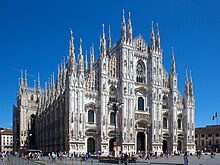
Milan Cathedral is the largest Gothic cathedral in the world.

Torre del Filarete of Sforza Castle (Castello Sforzesco), a historic medieval fortress.
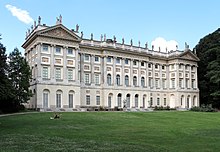
Royal Villa of Milan, one of the finest examples of Neoclassical architecture in Lombardy.

Art Deco Central railway station, the 8th busiest in Europe, opened in 1931.

The Cimitero Monumentale, it is noted for the abundance of artistic tombs and monuments.

The Arch of the Peace, 1807.
There are only few remains of the ancient Roman colony, notably the well-preserved Colonne di San Lorenzo. During the second half of the 4th century, Saint Ambrose, as bishop of Milan, had a strong influence on the layout of the city, reshaping the centre (although the cathedral and baptistery built in Roman times are now lost) and building the great basilicas at the city gates: Sant’Ambrogio, San Nazaro in Brolo, San Simpliciano and Sant’Eustorgio, which still stand, refurbished over the centuries, as some of the finest and most important churches in Milan. Milan’s Cathedral, built between 1386 and 1877, is the fifth-largest cathedral in the world[73] and the most important example of Gothic architecture in Italy. The gilt bronze statue of the Virgin Mary, placed in 1774 on the highest pinnacle of the Duomo, soon became one of the most enduring symbols of Milan.[74]
In the 15th century, when the Sforza ruled the city, an old Viscontean fortress was enlarged and embellished to become the Castello Sforzesco, the seat of an elegant Renaissance court surrounded by a walled hunting park. Notable architects involved in the project included the Florentine Filarete, who was commissioned to build the high central entrance tower, and the military specialist Bartolomeo Gadio.[75] The alliance between Francesco Sforza and Florence’s Cosimo de’ Medici bore to Milan Tuscan models of Renaissance architecture, apparent in the Ospedale Maggiore and Bramante’s work in the city, which includes Santa Maria presso San Satiro (a reconstruction of a small 9th-century church), the tribune of Santa Maria delle Grazie and three cloisters for Sant’Ambrogio.[76] The Counter-Reformation in the 16th to 17th centuries was also the period of Spanish domination and was marked by two powerful figures: Saint Charles Borromeo and his cousin, Cardinal Federico Borromeo. Not only did they impose themselves as moral guides to the people of Milan, but they also gave a great impulse to culture, with the creation of the Biblioteca Ambrosiana, in a building designed by Francesco Maria Ricchino, and the nearby Pinacoteca Ambrosiana. Many notable churches and Baroque mansions were built in the city during this period by the architects, Pellegrino Tibaldi, Galeazzo Alessi and Ricchino himself.[77]
Empress Maria Theresa of Austria was responsible for the significant renovations carried out in Milan during the 18th century.[78] This urban and artistic renewal included the establishment of Teatro alla Scala, inaugurated in 1778, and the renovation of the Royal Palace. The late 1700s Palazzo Belgioioso by Giuseppe Piermarini and Royal Villa of Milan by Leopoldo Pollack, later the official residence of Austrian viceroys, are often regarded among the best examples of Neoclassical architecture in Lombardy.[79] The Napoleonic rule of the city in 1805–1814, having established Milan as the capital of a satellite Kingdom of Italy, took steps in order to reshape it accordingly to its new status, with the construction of large boulevards, new squares (Porta Ticinese by Luigi Cagnola and Foro Bonaparte by Giovanni Antonio Antolini) and cultural institutions (Art Gallery and the Academy of Fine Arts).[80] The massive Arch of Peace, situated at the bottom of Corso Sempione, is often compared to the Arc de Triomphe in Paris. In the second half of the 19th century, Milan quickly became the main industrial centre of the new Italian nation, drawing inspiration from the great European capitals that were hubs of the Second Industrial Revolution. The great Galleria Vittorio Emanuele II, realised by Giuseppe Mengoni between 1865 and 1877 to celebrate Vittorio Emanuele II, is a covered passage with a glass and cast iron roof, inspired by the Burlington Arcade in London. Another late-19th-century eclectic monument in the city is the Cimitero Monumentale graveyard, built in a Neo-Romanesque style between 1863 and 1866.
The tumultuous period of early 20th century brought several, radical innovations in Milanese architecture. Art Nouveau, also known as Liberty in Italy, is recognisable in Palazzo Castiglioni, built by architect Giuseppe Sommaruga between 1901 and 1903.[81] Other examples include Hotel Corso,[81] Casa Guazzoni with its wrought iron and staircase, and Berri-Meregalli house, the latter built in a traditional Milanese Art Nouveau style combined with elements of neo-Romanesque and Gothic revival architecture, regarded as one of the last such types of architecture in the city.[82] A new, more eclectic form of architecture can be seen in buildings such as Castello Cova, built the 1910s in a distinctly neo-medieval style, evoking the architectural trends of the past.[83] An important example of Art Deco, which blended such styles with Fascist architecture, is the huge Central railway station inaugurated in 1931.[84]
The post–World War II period saw rapid reconstruction and fast economic growth, accompanied by a nearly two-fold increase in population. In the 1950s and 1960s, a strong demand for new residential and commercial areas drove to extreme urban expansion, that has produced some of the major milestones in the city’s architectural history, including Gio Ponti‘s Pirelli Tower (1956–60), Velasca Tower (1956–58), and the creation of brand new residential satellite towns, as well as huge amounts of low quality public housings. In recent years, de-industrialization, urban decay and gentrification led to a vast urban renewal of former industrial areas, that have been transformed into modern residential and financial districts, notably Porta Nuova in downtown Milan and FieraMilano in the suburb of Rho. In addition, the old exhibition area is being completely reshaped according to the Citylife regeneration project, featuring residencial areas, museums, an urban park and three skyscrapers designed by international architects, and after whom they are named: the 202-metre (663-foot) Isozaki Arata—when completed, the tallest building in Italy,[85] the twisted Hadid Tower,[86] and the curved Libeskind Tower.[87]
Parks and gardens[edit]

Sempione Park and the Arch of Peace.
The largest parks in the central area of Milan are Sempione Park, at the north-western edge, and Montanelli Gardens, situated northeast of the city. English-style Sempione Park, built in 1890, contains a Napoleonic Arena, the Milan City Aquarium, a steel lattice panoramic tower, an art exhibition centre, a Japanese garden and a public library.[88] The Montanelli gardens, created in the 18th century, hosts the Natural History Museum of Milan and a planetarium.[89] Slightly away from the city centre, heading east, Forlanini Park is characterised by a large pond and a few preserved shacks which remind of the area’s agricultural past.[90] In recent years Milan’s authorities pledged to develop its green areas: they planned to create twenty new urban parks and extend the already existing ones, and announced plans to plant three million trees by 2030.[91]
In addition, even though Milan is located in one of the most urbanised regions of Italy, it is surrounded by a belt of green areas and features numerous gardens even in its very centre. Since 1990, the farmlands and woodlands north (Parco Nord Milano) and south (Parco Agricolo Sud Milano) of the urban area have been protected as regional parks. West of the city, the Parco delle Cave (Sand pit park) has been established on a neglected site where gravel and sand used to be extracted, featuring artificial lakes and woods.
Demographics[edit]
| Year | Pop. | ±% |
|---|---|---|
| 1861 | 267,621 | — |
| 1871 | 290,518 | +8.6% |
| 1881 | 354,045 | +21.9% |
| 1901 | 538,483 | +52.1% |
| 1911 | 701,411 | +30.3% |
| 1921 | 818,161 | +16.6% |
| 1931 | 960,682 | +17.4% |
| 1936 | 1,115,794 | +16.1% |
| 1951 | 1,274,187 | +14.2% |
| 1961 | 1,582,474 | +24.2% |
| 1971 | 1,732,068 | +9.5% |
| 1981 | 1,604,844 | −7.3% |
| 1991 | 1,369,295 | −14.7% |
| 2001 | 1,256,211 | −8.3% |
| 2011 | 1,242,123 | −1.1% |
| 2018 | 1,378,689 | +11.0% |
| Istat historical data 1861–2011[92] | ||
The official estimated population of the City of Milan was 1,378,689 as of 31 December 2018, according to ISTAT, the official Italian statistical agency,[93] up by 136,556 from the 2011 census, or a growth of about 11%. At the same date 3,250,315 people lived in Milan province-level municipality.[94][95] The population of Milan today is lower than its historical peak. With rapid industrialization in post-war years, the population of Milan peaked at 1,743,427 in 1973.[96] Thereafter, during the following decades, about one third of the population moved to the outer belt of suburbs and new satellite settlements that grew around the city proper.
Today, Milan’s conurbation extends well beyond the borders of the city proper and of its special-status provincial authority: its contiguous built-up urban area was home to 5,270,000 people in 2015,[10] while its wider metropolitan area, the largest in Italy and fourth largest in the EU, is estimated to have a population of more than 8.2 million.[12]
Foreign residents[edit]
Foreign residents as of 2016 [97]
| Country of foreign nationality | showPopulation at 1 January 2019 |
|---|
As of 2016, some 260,421 foreign residents lived in the municipality of Milan,[97] representing 19% of the total resident population. These figures suggest that the immigrant population has more than doubled in the last 15 years.[98] After World War II, Milan experienced two main waves of immigration: the first, dating from the 1950s to the early 1970s, saw a large influx of migrants from poorer and rural areas within Italy; the second, starting from the late 1980s, has been characterised by the preponderance of foreign-born immigrants.[99] The early period coincided with the so-called Italian economic miracle of postwar years, an era of extraordinary growth based on rapid industrial expansion and great public works, that brought to the city a large influx of over 400,000 people, mainly from rural and underdeveloped Southern Italy.[46] In the last three decades, the foreign born share of the population soared. Immigrants came mainly from Africa (in particular Eritrean, Egyptian, Moroccans, Senegalese, and Nigerian), and the former socialist countries of Eastern Europe (notably Albania, Romania, Ukraine, Macedonia, Moldova, and Russia), in addition to a growing number of Asians (in particular Chinese, Sri Lankans and Filipinos) and Latin Americans (Mainly South Americans). At the beginning of the 1990s, Milan already had a population of foreign-born residents of approximately 58,000 (or 4% of the then population), that rose rapidly to over 117,000 by the end of the decade (about 9% of the total).[100]
Decades of continuing high immigration have made the city the most cosmopolitan and multicultural in Italy. Milan notably hosts the oldest and largest Chinese community in Italy, with almost 21,000 people in 2011.[101] Situated in the 9th district, and centred on Via Paolo Sarpi, an important commercial avenue, the Milanese Chinatown was originally established in the 1920s by immigrants from Wencheng County, in the Zhejiang province, and used to operate small textile and leather workshops.[102] Milan has also a substantial English-speaking community (more than 3,000 American, British and Australian expatriates[101]), and several English schools and language publications, such as Hello Milano, Where Milano and Easy Milano.
Religion[edit]

St. Ambrose Basilica dates back from AD 379–386.

Santa Maria delle Grazie, 1497.
Milan’s population, like that of Italy as a whole, is mostly Catholic.[103][104] It is the seat of the Roman Catholic Archdiocese of Milan. Greater Milan is also home to Protestant, Orthodox, Jewish, Muslim, Hindu, Sikh and Buddhist communities.[105][106][107][108][109]
Milan has been a Christian-majority city since the late Roman Empire.[110] Its religious history was marked by the figure of St. Ambrose, whose heritage includes the Ambrosian Rite (Italian: Rito ambrosiano), used by some five million Catholics in the greater part of the Archdiocese of Milan.[111] The Rite varies slightly from the canonical Roman Rite liturgy, with differences in the mass, liturgical year (Lent starts four days later than in the Roman Rite), baptism, rite of funerals, priest clothes, and sacred music (use of the Ambrosian chant rather than Gregorian).[112]
In addition, the city is home to the largest Orthodox community in Italy. Lombardy is the seat of at least 78 Orthodox parishes and monasteries, the vast majority of them located in the area of Milan.[113] The main Romanian Orthodox church in Milan is the Catholic church of Our Lady of Victory (Chiesa di Santa Maria della Vittoria), currently granted for use to the local Romanian community.[114] Similarly, the point of reference for the followers of the Russian Orthodox Church is the Catholic church of San Vito in Pasquirolo.[115][116]
The Jewish community of Milan is the second largest in Italy after Rome, with about 10,000 members, mainly Sephardi.[117] The main city synagogue, Hechal David u-Mordechai Temple, was built by architect Luca Beltrami in 1892.
Milan hosts also one of the largest Muslim communities in Italy,[118] and the city saw the construction of the country’s first new mosque featuring a dome and minaret, since the destruction of the ancient mosques of Lucera in the year 1300. In 2014 the City Council agreed on the construction of a new mosque amid bitter political debate, since it is strenuously opposed by right-wing parties such as the Northern League.[119]
Currently, accurate statistics on the Hindu and Sikh presence in Milan metro area are not available; however, various sources estimate that about 40% of the total Indian population living in Italy, or about 50,000 individuals, reside in Lombardy,[120][121] where a number of Hindu and Sikh temples exist and where they form the largest such communities in Europe after the ones in Britain.[122]
Economy[edit]

The skyscrapers of Porta Nuova business district.

New towers in CityLife business district.
Whereas Rome is Italy’s political capital, Milan is the country’s industrial and financial heart. With a 2014 GDP estimated at €158.9 billion,[123] the province of Milan generates approximately 10% of the national GDP; while the economy of the Lombardy region generates approximately 22% of Italy’s GDP (or an estimated €357 billion in 2015,[124] roughly the size of Belgium). The province of Milan is home to about 45% of businesses in the Lombardy region and more than 8 percent of all businesses in Italy, including three Fortune 500 companies.[125]
Milan was the 11th most expensive city in Europe and the 22nd most expensive city in the world in 2019,[126] according to the Economist Intelligence Unit, while the well-known Via Monte Napoleone is Europe’s most expensive shopping street according to Global Blue.[127]
Since the late 1800s, the area of Milan has been a major industrial and manufacturing centre. Alfa Romeo automobile company and Falck steel group employed thousands of workers in the city until the closure of their sites in Arese in 2004 and Sesto San Giovanni in 1995. Other global industrial companies, such as Edison, Pirelli, Prysmian Group, Riva Group, Saras, Saipem and Techint, maintain their headquarters and significant employment in the city and its suburbs. Other relevant industries active in metro Milan include chemicals (e.g. Mapei, Versalis, Tamoil Italy), home appliances (e.g. Candy), hospitality (UNA Hotels & Resorts), food & beverages (e.g. Bertolli, Campari), machinery, medical technologies (e.g. Amplifon, Bracco), plastics and textiles. The construction (e.g. Salini), retail (e.g. Esselunga, La Rinascente) and utilities (e.g. Edison S.p.A., Snam) sectors are also large employers in the Greater Milan.

Milan Stock Exchange, Italy’s main stock exchange.
Milan is Italy’s largest financial hub. The main national insurance companies and banking groups (for a total of 198 companies) and over forty foreign insurance and banking companies are located in the city,[128] as well as a number of asset management companies, including Azimut Holding, ARCA SGR, and Eurizon Capital. The Associazione Bancaria Italiana representing the Italian banking system, and Milan Stock Exchange (225 companies listed on the stock exchange) are both located in the city. Porta Nuova, the main business district of Milan and one of the most important in Europe, hosts the Italian headquarters of numerous global companies, such as Accenture, AXA, Bank of America, BNP Paribas, Celgene, China Construction Bank, Finanza & Futuro Banca, FinecoBank, FM Global, Herbalife, HSBC, KPMG, Maire Tecnimont, Mitsubishi UFJ Financial Group, Panasonic, Samsung, Shire, Tata Consultancy Services, Telecom Italia, UniCredit, UnipolSai. Other large multinational service companies, such as Allianz, Generali, Alleanza Assicurazioni and PricewaterhouseCoopers, have their headquarters in the recently built towers of the CityLife business district, a new 900-acre-wide (3.6 km2) development project designed by prominent modernist architects Zaha Hadid, Daniel Liebskind and Arata Isozaki.
The city is home to numerous media and advertising agencies, national newspapers and telecommunication companies, including both the public service broadcaster RAI and private television companies like Mediaset, La7 and Sky Italia. In addition, it hosts the headquarters of the largest Italian publishing companies, such as Feltrinelli, Mondadori, RCS Media Group, Messaggerie Italiane, and Giunti Editore. Milan has also seen a rapid increase in the presence of IT companies, with both domestic and international companies such as Altavista, Google, Exprivia, Lycos, Microsoft,[129] Virgilio and Yahoo! establishing their Italian operations in the city.
Milan is one of the fashion capitals of the world, where the sector can count on 12,000 companies, 800 show rooms, and 6,000 sales outlets; the city hosts the headquarters of global fashion houses such as Armani, Dolce & Gabbana, Luxottica, Prada, Versace, Valentino, Zegna and four weeks a year are dedicated to fashion events.[128] The city is also a global hub for event management and trade fairs. FieraMilano operates the world’s fourth largest[130] exhibition hall in Rho, were international exhibitions like Milan Furniture Fair, EICMA, EMO take place on 400,000 square metres of exhibition areas with more than 4 million visitors in 2018.[131]
Tourism is an increasingly important part of the city’s economy: with 8.81 million registered international arrivals in 2018 (up 9.92% on the previous year), Milan ranked as the world’s 15th-most visited city.[132]
Culture[edit]
Museums and art galleries[edit]
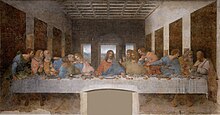
Leonardo da Vinci‘s The Last Supper, together with the church of Santa Maria delle Grazie, is a UNESCO World Heritage Site.
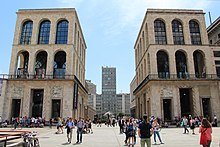
The Museo del Novecento displays the world’s largest collection of Futurist art.[133]
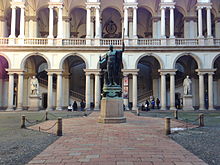
The Pinacoteca di Brera.
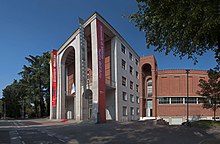
The Triennale, design and art museum.

The San Carlo al Corso.
Milan is home to many cultural institutions, museums and art galleries, that account for about a tenth of the national total of visitors and receipts.[134] The Pinacoteca di Brera is one of Milan’s most important art galleries. It contains one of the foremost collections of Italian painting, including masterpieces such as the Brera Madonna by Piero della Francesca. The Castello Sforzesco hosts numerous art collections and exhibitions, especially statues, ancient arms and furnitures, as well as the Pinacoteca del Castello Sforzesco, with an art collection including Michelangelo‘s last sculpture, the Rondanini Pietà, Andrea Mantegna‘s Trivulzio Madonna and Leonardo da Vinci‘s Codex Trivulzianus manuscript. The Castello complex also includes The Museum of Ancient Art, The Furniture Museum, The Museum of Musical Instruments and the Applied Arts Collection, The Egyptian and Prehistoric sections of the Archaeological Museum and the Achille Bertarelli Print Collection.
Milan’s figurative art flourished in the Middle Ages, and with the Visconti family being major patrons of the arts, the city became an important centre of Gothic art and architecture (Milan Cathedral being the city’s most formidable work of Gothic architecture). Leonardo worked in Milan from 1482 until 1499. He was commissioned to paint the Virgin of the Rocks for the Confraternity of the Immaculate Conception and The Last Supper for the monastery of Santa Maria delle Grazie.[135]
The city was affected by the Baroque in the 17th and 18th centuries, and hosted numerous formidable artists, architects and painters of that period, such as Caravaggio and Francesco Hayez, which several important works are hosted in Brera Academy. The Museum of Risorgimento is specialised on the history of Italian unification Its collections include iconic paintings like Baldassare Verazzi‘s Episode from the Five Days and Francesco Hayez‘s 1840 Portrait of Emperor Ferdinand I of Austria. The Triennale is a design museum and events venue located in Palazzo dell’Arte, in Sempione Park. It hosts exhibitions and events highlighting contemporary Italian design, urban planning, architecture, music, and media arts, emphasising the relationship between art and industry.
Milan in the 20th century was the epicentre of the Futurist artistic movement. Filippo Marinetti, the founder of Italian Futurism wrote in his 1909 “Manifesto of Futurism” (in Italian, Manifesto Futuristico), that Milan was “grande…tradizionale e futurista” (“grand…traditional and futuristic“, in English). Umberto Boccioni was also an important Futurism artist who worked in the city. Today, Milan remains a major international hub of modern and contemporary art, with numerous modern art galleries. The Modern Art Gallery, situated in the Royal Villa, hosts collections of Italian and European painting from the 18th to the early 20th centuries.[136][137][138] The Museo del Novecento, situated in the Palazzo dell’Arengario, is one of the most important art galleries in Italy about 20th-century art; of particular relevance are the sections dedicated to Futurism, Spatialism and Arte povera. In the early 1990s architect David Chipperfield was invited to convert the premises of the former Ansaldo Factory into a Museum. Museo delle Culture (MUDEC) opened in April 2015.[139] The Gallerie di Piazza Scala, a modern and contemporary museum located in Piazza della Scala in the Palazzo Brentani and the Palazzo Anguissola, hosts 195 artworks from the collections of Fondazione Cariplo with a strong representation of nineteenth-century Lombard painters and sculptors, including Antonio Canova and Umberto Boccioni. A new section was opened in the Palazzo della Banca Commerciale Italiana in 2012. Other private ventures dedicated to contemporary art include the exhibiting spaces of the Prada Foundation and HangarBicocca. The Nicola Trussardi Foundation is renewed for organising temporary exhibition in venues around the city. Milan is also home to many public art projects, with a variety of works that range from sculptures to murals to pieces by internationally renowned artists, including Arman, Kengiro Azuma, Francesco Barzaghi, Alberto Burri, Pietro Cascella, Maurizio Cattelan, Leonardo Da Vinci, Giorgio de Chirico, Kris Ruhs, Emilio Isgrò, Fausto Melotti, Joan Miró, Carlo Mo, Claes Oldenburg, Igor Mitoraj, Gianfranco Pardi, Michelangelo Pistoletto, Arnaldo Pomodoro, Carlo Ramous, Aldo Rossi, Aligi Sassu, Giuseppe Spagnulo and Domenico Trentacoste.
Music[edit]
Milan is a major national and international centre of the performing arts, most notably opera. The city hosts La Scala operahouse, considered one of the world’s most prestigious,[141] having throughout history witnessed the premieres of numerous operas, such as Nabucco by Giuseppe Verdi in 1842, La Gioconda by Amilcare Ponchielli, Madama Butterfly by Giacomo Puccini in 1904, Turandot by Puccini in 1926, and more recently Teneke, by Fabio Vacchi in 2007. Other major theatres in Milan include the Teatro degli Arcimboldi, Teatro Dal Verme, Teatro Lirico and formerly the Teatro Regio Ducal. The city is also the seat of a renowned symphony orchestra and musical conservatory, and has been, throughout history, a major centre for musical composition: numerous famous composers and musicians such as Gioseppe Caimo, Simon Boyleau, Hoste da Reggio, Verdi, Giulio Gatti-Casazza, Paolo Cherici and Alice Edun lived and worked in Milan. The city is also the birthplace of many modern ensembles and bands, including Camaleonti, Camerata Mediolanense, Gli Spioni, Dynamis Ensemble, Elio e le Storie Tese, Krisma, Premiata Forneria Marconi, Quartetto Cetra, Stormy Six and Le Vibrazioni.
Fashion and design[edit]

Galleria Vittorio Emanuele II is one of the city’s largest shopping centres.
Milan is widely regarded as a global capital in industrial design, fashion and architecture.[142] In the 1950s and 60s, as the main industrial centre of Italy and one of Europe’s most dynamic cities, Milan became a world capital of design and architecture. There was such a revolutionary change that Milan’s fashion exports accounted for US$726 million in 1952, and by 1955 that number grew to US$72.5 billion.[143] Modern skyscrapers, such as the Pirelli Tower and the Torre Velasca were built, and artists such as Bruno Munari, Lucio Fontana, Enrico Castellani and Piero Manzoni gathered in the city.[144] Today, Milan is still particularly well known for its high-quality furniture and interior design industry. The city is home to FieraMilano, Europe’s largest permanent trade exhibition, and Salone Internazionale del Mobile, one of the most prestigious international furniture and design fairs.[145]
Milan is also regarded as one of the fashion capitals of the world, along with New York City, Paris, and London.[146] Milan is synonymous with the Italian prêt-à-porter industry,[147] as many of the most famous Italian fashion brands, such as Valentino, Gucci, Versace, Prada, Armani and Dolce & Gabbana, are headquartered in the city. Numerous international fashion labels also operate shops in Milan. Furthermore, the city hosts the Milan Fashion Week twice a year, one of the most important events in the international fashion system.[148] Milan’s main upscale fashion district, quadrilatero della moda, is home to the city’s most prestigious shopping streets (Via Monte Napoleone, Via della Spiga, Via Sant’Andrea, Via Manzoni and Corso Venezia), in addition to Galleria Vittorio Emanuele II, one of the world’s oldest shopping malls.[149]
Languages and literature[edit]

Monument to Alessandro Manzoni.
In the late 18th century, and throughout the 19th, Milan was an important centre for intellectual discussion and literary creativity. The Enlightenment found here a fertile ground. Cesare, Marquis of Beccaria, with his famous Dei delitti e delle pene, and Count Pietro Verri, with the periodical Il Caffè were able to exert a considerable influence over the new middle-class culture, thanks also to an open-minded Austrian administration.
In the first years of the 19th century, the ideals of the Romantic movement made their impact on the cultural life of the city and its major writers debated the primacy of Classical versus Romantic poetry. Here, too, Giuseppe Parini, and Ugo Foscolo published their most important works, and were admired by younger poets as masters of ethics, as well as of literary craftsmanship. Foscolo’s poem Dei sepolcri was inspired by a Napoleonic law that—against the will of many of its inhabitants—was being extended to the city.
In the third decade of the 19th century, Alessandro Manzoni wrote his novel I Promessi Sposi, considered the manifesto of Italian Romanticism, which found in Milan its centre; in the same period Carlo Porta, reputed the most renowned local vernacular poet, wrote his poems in Lombard Language. The periodical Il Conciliatore published articles by Silvio Pellico, Giovanni Berchet, Ludovico di Breme, who were both Romantic in poetry and patriotic in politics.
After the Unification of Italy in 1861, Milan lost its political importance; nevertheless it retained a sort of central position in cultural debates. New ideas and movements from other countries of Europe were accepted and discussed: thus Realism and Naturalism gave birth to an Italian movement, Verismo. The greatest verista novelist, Giovanni Verga, was born in Sicily but wrote his most important books in Milan.
In addition to Italian, approximately 2 million people in the Milan metropolitan area can speak the Milanese dialect or one of its Western Lombard variations.[150]
Media[edit]
Milan is an important national and international media centre. Corriere della Sera, founded in 1876, is one of the oldest Italian newspapers, and it is published by Rizzoli, as well as La Gazzetta dello Sport, a daily dedicated to coverage of various sports and currently considered the most widely read daily newspaper in Italy. Other local dailies are the general broadsheets Il Giorno, Il Giornale, the Roman Catholic Church-owned Avvenire, and Il Sole 24 Ore, a daily business newspaper owned by Confindustria (the Italian employers’ federation). Free daily newspapers include Leggo and Metro. Milan is also home to many architecture, art, and fashion periodicals, including Abitare, Casabella, Domus, Flash Art, Gioia, Grazia, and Vogue Italia. Panorama and Oggi, two of Italy’s most important weekly news magazines, are also published in Milan.
Several commercial broadcast television networks have their national headquarters in the Milan conurbation, including Mediaset Group (owner of Canale 5, Italia 1, Iris and Rete 4), Telelombardia and MTV Italy. National radio stations based in Milan include Radio Deejay, Radio 105 Network, R101 (Italy), Radio Popolare, RTL 102.5, Radio Capital and Virgin Radio Italia.
Cuisine[edit]
Like most cities in Italy, Milan has developed its own local culinary tradition, which, as it is typical for North Italian cuisines, uses more frequently rice than pasta, butter than vegetable oil and features almost no tomato or fish. Milanese traditional dishes includes cotoletta alla milanese, a breaded veal (pork and turkey can be used) cutlet pan-fried in butter (similar to Viennese Wiener Schnitzel). Other typical dishes are cassoeula (stewed pork rib chops and sausage with Savoy cabbage), ossobuco (braised veal shank served with a condiment called gremolata), risotto alla milanese (with saffron and beef marrow), busecca (stewed tripe with beans), and brasato (stewed beef or pork with wine and potatoes).
Season-related pastries include chiacchiere (flat fritters dusted with sugar) and tortelli (fried spherical cookies) for Carnival, colomba (glazed cake shaped as a dove) for Easter, pane dei morti (“bread of the (Day of the ) Dead”, cookies flavoured with cinnamon) for All Souls’ Day and panettone for Christmas. The salame Milano, a salami with a very fine grain, is widespread throughout Italy. Renowned Milanese cheeses are gorgonzola (from the namesake village nearby), mascarpone, used in pastry-making, taleggio and quartirolo.
Milan is well known for its world-class restaurants and cafés, characterised by innovative cuisine and design.[151] As of 2014, Milan has 157 Michelin-selected places, including three 2-Michelin-starred restaurants;[152] these include Cracco, Sadler and il Luogo di Aimo e Nadia.[153] Many historical restaurants and bars are found in the historic centre, the Brera and Navigli districts. One of the city’s oldest surviving cafés, Caffè Cova, was established in 1817.[154] In total, Milan has 15 cafés, bars and restaurants registered among the Historical Places of Italy, continuously operating for at least 70 years.[155]
Sport[edit]

San Siro Stadium, home of A.C. Milan and Inter Milan, has an 80,000 capacity. It is Italy’s biggest stadium.

Mediolanum Forum, home of Olimpia Milano.

The Monza Formula One circuit is located near the city, inside a suburban park.
Milan hosted the FIFA World Cup in 1934 and 1990, the UEFA European Football Championship in 1980 and most recently the 2003 World Rowing Championships, the 2009 World Boxing Championships, and some games of the Men’s Volleyball World Championship in 2010 and the final games of the Women’s Volleyball World Championship in 2014. In 2018, Milan hosted World Figure Skating Championships. Milan will host the 2026 Winter Olympics as well as the 2026 Winter Paralympics jointly with Cortina d’Ampezzo.
Milan is the only city in Europe that is home to two European Cup/Champions League winning teams—Serie A football clubs Milan and Inter. Both teams have also won the Intercontinental Cup (now FIFA Club World Cup). With a combined ten Champions League titles, Milan is second after Madrid as city that have won the most European Cups. They are one of the most successful clubs in the world of football in terms of international trophies. Both teams play at the UEFA 5-star-rated Giuseppe Meazza Stadium, more commonly known as the San Siro, that is one of the biggest stadiums in Europe, with a seating capacity of over 80,000.[156] The Meazza Stadium hosted the 2016 UEFA Champions League Final, in which Real Madrid defeated Atlético Madrid 5–3 in a penalty shoot out. A third team, Brera Calcio F.C. plays in Promozione.[157] Another team, Milano City F.C. (formerly of ASD Bustese)[158] plays in Serie D.
Milan is one of the host cities of the EuroBasket 2022. There are currently four professional Lega Basket clubs in Milan: Olimpia Milano, Pallacanestro Milano 1958, Società Canottieri Milano and A.S.S.I. Milano. Olimpia is the most titled basketball club in Italy, having won 27 Italian League championships, six Italian National Cups, one Italian Super Cup, three European Champions Cups, one FIBA Intercontinental Cup, three FIBA Saporta Cups, two FIBA Korać Cups and many junior titles. The team play at the Mediolanum Forum, with a capacity of 12,700 where it has been hosted the final of the 2013–14 Euroleague. In some cases the team play also at the PalaDesio, with a capacity of 6,700.
Milan is also home to Italy’s oldest American football team: Rhinos Milano, that won 5 Italian Super Bowls. The team play at the Velodromo Vigorelli, with a capacity of 8,000. Milan has also two cricket teams, Milano Fiori (currently competing in the second division) and Kingsgrove Milan, who won the Serie A championship in 2014. Amatori Rugby Milano, the most titled rugby team in Italy, was founded in Milan in 1927. The Monza Formula One circuit is located near the city, inside a suburban park. It is one of the world’s oldest car racing circuits. The capacity for the F1 races is currently of over 113,000. It has hosted an F1 race nearly every year since the first year of competition, with the exception of 1980.
In road cycling, Milan hosts the start of the annual Milan–San Remo classic one-day race and the annual Milano–Torino one day race. Milan is also the traditional finish for the final stage of the Giro d’Italia, which, along with the Tour de France and the Vuelta a Espana, is one of cycling’s three Grand Tours.
Education[edit]
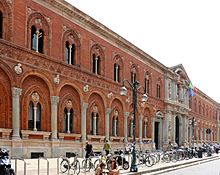
The University of Milan headquarter

Bocconi University is a leading institution for economics, management and related disciplines in Europe.[159]

University of Milan Bicocca, the city’s newest university, ranks as the 82nd best young college on over 300 institutions in the 2020 Times Higher Education World University Rankings.[160]
Milan is a major global centre of higher education teaching and research and has the second largest concentration of higher education institutes in Italy after Rome. Milan’s higher education system includes 7 universities, 48 faculties and 142 departments, with 185,000 university students enrolled in 2011 (approximately 11 percent of the national total)[20] and the largest number of university graduates and postgraduate students (34,000 and more than 5,000, respectively) in Italy.[161]
The Polytechnic University of Milan is the city’s oldest university, founded in 1863. With over 40,000 students, it is the largest technical university in Italy.[162]
The University of Milan, founded in 1923, is the largest public teaching and research university in the city.[163] The University of Milan is the sixth-largest university in Italy, with approximately 60,000 enrolled students and a teaching staff of 2,500.[164]
Università Cattolica del Sacro Cuore is the largest Catholic university in the world with 42,000 enrolled students.[165]
Bocconi University is a private management and finance school established in 1902, ranking as the sixth best business school in Europe as of 2018.[166] Bocconi University also ranks as the 5th best 1 year MBA course in the world, according to the Forbes 2017 ranking.[167]
University of Milan Bicocca is the city’s newest high education institution, founded in 1998 in an effort to alleviate pressure on the overcrowded University of Milan. Bicocca, built over abandoned industrial estates, today enrolls more than 30,000 students and ranks high in international rankings on young universities;[168]
IULM University of Milan was established in 1968 as the first Italian tertiary institution offering courses on public relations; later it became a point of reference also for business communication; media and advertising; interpreting; communication in culture and arts markets, tourism and fashion.[169]
Vita-Salute San Raffaele University is a medical university linked to the San Raffaele Hospital.[170]
Milan is also well known for its fine arts and music schools. The Milan Academy of Fine Arts (Brera Academy) is a public academic institution founded in 1776 by Empress Maria Theresa of Austria; the New Academy of Fine Arts is the largest private art and design university in Italy;[171] the European Institute of Design is a private university specialised in fashion, industrial and interior design, audio/visual design including photography, advertising and marketing and business communication; the Marangoni Institute, is a fashion institute with campuses in Milan, London, and Paris; the Domus Academy is a private postgraduate institution of design, fashion, architecture, interior design and management; the Pontifical Ambrosian Institute of Sacred Music, a college of music founded in 1931 by the blessed cardinal A.I. Schuster, archbishop of Milan, and raised according to the rules by the Holy See in 1940, is—similarly to the Pontifical Institute of Sacred Music in Rome, which is consociated with—an Institute “ad instar facultatis” and is authorised to confer university qualifications with canonical validity[172] and the Milan Conservatory, a college of music established in 1807, currently Italy’s largest with more than 1,700 students and 240 music teachers.[173]
Transport[edit]
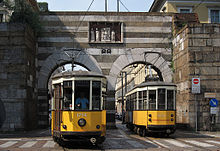
Typical trams operated by ATM

Milan Metro is Italy’s longest rapid transit system.
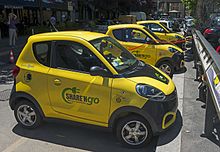
Sharen’go cars in Piazza Duca d’Aosta
Milan is one the key transport nodes of Italy and southern Europe. Its central railway station is Italy’s second and Europe’s eighth busiest.[174][175] The Malpensa, Linate and Orio al Serio airports serve the Greater Milan, the largest metropolitan area in Italy.
Azienda Trasporti Milanesi (ATM) is the Milanese municipal transport company; it operates 4 metro lines, 18 tram lines, 131 bus lines and 4 trolleybus lines, carrying about 776 million passengers in 2018.[176] Overall the network covers nearly 1,500 km (932 mi) reaching 46 municipalities.[177] Besides public transport, ATM manages the interchange parking lots and other transport services including bike sharing and carsharing systems.[178]
Rail[edit]
Underground[edit]
The Milan Metro is the rapid transit system serving the city and surrounding municipalities. The network consists of 4 lines (plus one under construction), with a total network length of 101 kilometres (63 mi), and a total of 113 stations, mostly underground.[179] It has a daily ridership of 1.15 million,[180] the largest in Italy as well as one of the largest in Europe.
Suburban[edit]
The Milan suburban railway service, operated by Trenord, comprises 12 S lines connecting the metropolitan area with the city center, with possible transfers to all the metro lines. Most S lines run through the Milan Passerby railway, commonly referred to as “il Passante” and served by double-decker trains every 4/8 minutes in the central underground section.[181]
National and international trains[edit]
Milan Central station, with 120 million passengers per year, is the eight busiest railway station in Europe and the second in Italy after Rome.[174] Milano Cadorna and Milano Porta Garibaldi stations are respectively the seventh and the eleventh busiest stations in Italy.[174] Since the end of 2009, two high-speed train lines link Milan to Rome, Naples and Turin, considerably shortening travel times with other major cities in Italy. Further high-speed lines are under construction towards Genoa and Verona. Milan is served by direct international trains to Nice, Marseille, Lyon, Paris, Lugano, Geneva, Bern, Basel, Zurich and Frankfurt, and by overnight sleeper services to Paris and Dijon (Thello), Munich and Vienna (ÖBB).[182]
Milan is also the core of Lombardy‘s regional train network. Regional trains were operated on two different systems by LeNord (departing from Milano Cadorna) and Trenitalia (departing from Milan Centrale and Milano Porta Garibaldi). Since 2011, a new company, Trenord, operates both Trenitalia and LeNord regional trains in Lombardy, carrying over 750,000 passengers on more than 50 routes every day.[183][184]
Buses and trams[edit]
The city tram network consists of approximately 160 kilometres (99 mi) of track and 18 lines, and is Europe’s most advanced light rail system.[185] Bus lines cover over 1,070 km (665 mi). Milan has also taxi services operated by private companies and licensed by the City council of Milan. The city is also a key node for the national road network, being served by all the major highways of Northern Italy. Numerous long-distance bus lines link Milan with many other cities and towns in Lombardy and throughout Italy.[186]
Aviation[edit]
The Milan metropolitan area is served by three international airports, with a grand total of about 47 million passengers served in 2018.[187]
- Malpensa Airport is Italy’s second-busiest airport with 24.7 million passengers served in 2018 and Italy’s busiest for freight and cargo, handling about 600,000 tons of international freight in 2018. Malpensa lays 45 km (28 mi) from downtown Milan and is connected to the city by the Malpensa Express railway service.[188]
- Linate Airport, the oldest, is Milan’s city airport, and is now mainly used for domestic and short-haul international flights, serving 9.2 million passengers in 2018. Linate Airport is the second largest base for Italian nation’s flag carrier, Alitalia.[189]
- Orio al Serio Airport, located some 50 km (31 mi) away, near the town of Bergamo, mainly serves the low-cost traffic of Milan and it is the main base of Ryanair (12.9 million passengers served in 2018).[190]
Lastly, Bresso Airfield is a general aviation airport, operated by Aero Club Milano.[191]
International relations[edit]
Twin towns – sister cities[edit]
Milan has fifteen official sister cities as reported on the city’s website.[192] The date column indicates the year in which the relationship was established. São Paulo was Milan’s first sister city.
| City | Country | Date |
|---|---|---|
| São Paulo | Brazil | 1961 |
| Chicago | United States | 1962 |
| Lyon | France | 1967 |
| Frankfurt | Germany | 1969 |
| Birmingham | United Kingdom | 1974 |
| Dakar | Senegal | 1974 |
| Shanghai | China | 1979 |
| Osaka | Japan | 1981 |
| Tel Aviv | Israel | 1997 |
| Bethlehem | Palestine | 2000 |
| Toronto | Canada | 2003 |
| Kraków[193] | Poland | 2003 |
| Melbourne | Australia | 2004 |
| Daegu[194] | South Korea | 2015 |
The partnership with the city of St. Petersburg, Russia, that started in 1967, was suspended in 2012 (a decision taken by the city of Milan), because of the prohibition of the Russian government on “homosexual propaganda”.[195]
Other relations[edit]
Milan has the following collaborations:[196]
- Algiers, Algeria
- Amsterdam, Netherlands
- Barcelona, Spain
- Bilbao, Spain
- Chengdu, China
- Copenhagen, Denmark
- Guangzhou, China
- Dubai, United Arab Emirates
- Moscow, Russia
- New York City, United States
- Nur-Sultan, Kazakhstan
- Saitama Prefecture, Japan
- Tegucigalpa, Honduras
- Tehran, Iran
Notable people[edit]
Honorary citizens[edit]
People awarded the honorary citizenship of Milan are:
| Date | Name | Notes |
|---|---|---|
| 24 February 1972 | Charlie Chaplin (1889 – 1977) | English comic actor. |
| March 1980 | Andrei Sakharov (1921 – 1989) | Russian nuclear physicist, dissident and activist |
| December 1988 | Alexander Dubček (1921 – 1992) | Czechoslovak and Slovak politician and dissident |
| 16 February 1990 | Paola Borboni (1900 – 1995) | Italian actress. |
| 21 October 2004 | Rudolph Giuliani (1944 – present) | American politician, former Mayor of New York City, and attorney of Donald Trump. |
| 3 September 2005 | Rania Al-Abdullah (1970 – present) | Queen consort of Jordan. |
| 10 December 2008 | Al Gore (1948 – present) | American politician and former Vice President of the United States. |
| 18 January 2012 | Roberto Saviano (1979 – present) | Italian journalist and writer. |
| 4 April 2016 | Nino Di Matteo (1961 – present) | Italian magistrate. |
| 20 October 2016 | Dalai Lama (1935 – present) | Tibetan Buddhist Spiritual Leader.[197][198] |

